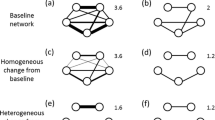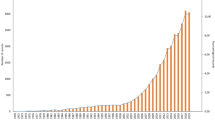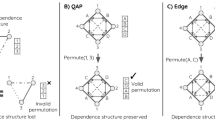Abstract
Researchers are increasingly turning to network theory to understand the social nature of animal populations. We present a computational framework that is the first step in a series of works that will allow us to develop a quantitative methodology of social network sampling to aid ecologists in their social network data collection. To develop our methodology, we need to be able to generate networks from which to sample. Ideally, we need to perform a systematic study of sampling protocols on different known network structures, as network structure might affect the robustness of any particular sampling methodology. Thus, we present a computational tool for generating network structures that have user-defined distributions for network properties and for key measures of interest to ecologists. The user defines the values of these measures and the tool will generate appropriate network randomizations with those properties. This tool will be used as a framework for developing a sampling methodology, although we do not present a full methodology here. We describe the method used by the tool, demonstrate its effectiveness, and discuss how the tool can now be utilized. We provide a proof-of-concept example (using the assortativity measure) of how such networks can be used, along with a simulated egocentric sampling regime, to test the level of equivalence of the sampled network to the actual network.








Similar content being viewed by others
References
Barabási A-L, Albert R (1999) Emergence of scaling in random networks. Science 286:509–512
Borgatti SP, Everett MG, Freeman LC (1999) UCINET 5.0 Version 1.0. Analytic Technologies, Natick
Borgatti SP, Carley KM, Krackhardt D (2006) On the robustness of centrality measures under conditions of imperfect data. Soc Netw 28:124–136
Costenbader E, Valente TW (2003) The stability of centrality measures when networks are sampled. Soc Netw 25:283–307
Croft DP, Krause J, James R (2004) Social networks in the guppy (Poecilia reticulata). Proc R Soc Biol Lett 271:516–519
Frank O (ed) (1979) In: Estimation of population totals by use of snowball samples. Academic, New York
James R, Croft DP, Krause J (2009) Potential banana skins in animal social network analysis. Behav Ecol Sociobiol. doi:10.1007/s00265-009-0742-5
Kossinets G (2006) Effects of missing data in social networks. Soc Networks 28:247–268
Krause J, Lusseau D, James R (2009) Animal social networks: an introduction. Behav Ecol Sociobiol. doi:10.1007/s00265-009-0747-0
Lee SH, Kim P, Jeong H (2006) Statistical properties of sampled networks. Phys Rev E 73:016102
Lusseau D, Newman MEJ (2004) Identifying the role that individual animals play in their social network. Proc R Soc Biol Lett 271:S477–S481
Mitchell M (1998) An introduction to genetic algorithms. MIT, Cambridge
Newman MEJ (2002) Assortative mixing in networks. Phys Rev Lett 89:208701
Newman MEJ, Park J (2003) Why social networks are different from other types of networks. Phys Rev E 68:36122
Noble J, Davy S, Franks DW (2004) Effects of the topology of social networks on information transmission. In Schaal AJIS, Billard A, Vijayakumar S (eds) From animals to animats 8: Proceedings of the Eighth International Conference on Simulation of Adaptive Behavior, pp 395–404
Sibbald A, Elston D, Smith D, Erhard H (2005) A method for assessing the relative sociability of individuals within groups: an example with grazing sheep. Appl Anim Behav Sci 91:57–73
Sih A, Hanser S, McHugh K (2009) Social network theory: new insights and issues for behavioral ecologists. Behav Ecol Sociobiol. doi:10.1007/s00265-009-0725-6
Wasserman S, Faust K, Iacobucci K (1994) Social network analysis: methods and applications. Cambridge University Press, New York
Watts DJ, Strogatz SH (1998) Collective dynamics of ‘small-world’ networks. Nature 393:440–442
Whitehead H, Dufault S (1999) Techniques for analyzing vertebrate social structure using identified individuals: Review and recommendations. Adv Study Behav 28:33–74
Yoon S, Lee S, Yook S, Kim Y (2007) Statistical properties of sampled networks by random walks. Phys Rev E 75:046114
Acknowledgements
We are grateful to Darren Croft, Jens Krause, David Mawdsley, Jon Pitchford, Jamie Wood, Stefan Krause, and an anonymous referee for comments and suggestions. DWF is funded for this project by NERC grant NE/E016111/1.
Author information
Authors and Affiliations
Corresponding author
Additional information
Communicated by Guest Editor J. Krause
This contribution is part of the special issue “Social Networks: new perspectives” (Guest Editors: J. Krause, D. Lusseau and R. James).
Rights and permissions
About this article
Cite this article
Franks, D.W., James, R., Noble, J. et al. A foundation for developing a methodology for social network sampling. Behav Ecol Sociobiol 63, 1079–1088 (2009). https://doi.org/10.1007/s00265-009-0729-2
Received:
Revised:
Accepted:
Published:
Issue Date:
DOI: https://doi.org/10.1007/s00265-009-0729-2




